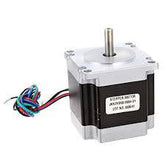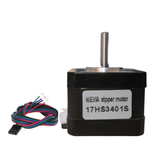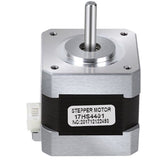NEMA 17 - The High Torque Stepper Motor Working Principle
Summary
Do you want to discover the world of NEMA17 stepper motors? If the answer is Yes! Then this comprehensive guide covers all the essential information for the NEMA17 stepper motors like the mechanism, features, specifications, pin description, usage and applications. Whether you're a professional or hobbyist, you won't miss out on this valuable information that could revolutionize how you use NEMA17 stepper motors.
What is NEMA17?
Even the most basic electronics typically include an electric motor. As a result, it is crucial, particularly in systems that incorporate rotational motion. However, not all engines can be beneficial in circumstances when accuracy is required. The NEMA 17 stepper motors are useful in this situation. We're going to give you all the important information about how this component works.
Fig.1. Dis-assembled electric step motor parts
NEMA 17 Stepper motor has a 1.8° step angle. There are 200 steps or revolutions per angle. Each phase of the motor type can draw a voltage of 12V when it is in operation.
As a result, the current can maintain a holding torque of 3.2 kg-cm. Keep in mind that the motor type has six wires that are color-coded as well. Additionally, a bare lead is present on each cable.
To provide control by unipolar and bipolar stepper motor drivers, cables are therefore essential.
A stepper motor, also known as a step motor or stepping motor, is a brushless DC electric motor that separates a whole rotation into many equal steps.
Without a position sensor to provide input, the motor's position can be told to move and hold at one of these phases as long as it is scaled correctly for the application in terms of torque and speed (an open-loop controller). Switched reluctance motors are large stepping motors with fewer poles.
Mechanism of the Stepper Motor:
When DC voltage is applied to the terminals of brushed DC motors, the motors continue to spin. Stepper motors are well known for their ability to transform input pulse trains (usually composed of square waves) into accurate increments in rotational position. Each pulse rotates the shaft through a fixed angle.
Fig.2. Stepper Motor
A stepper motor consists of several "toothed" electromagnets arranged as a stator revolving around a central iron rotor. One electromagnet is powered to magnetically attract the gear teeth and turn the motor shaft.
When lined up with the first electromagnet, the gear teeth are slightly offset from the next electromagnet. By turning off one electromagnet and turning on the next, the gear spins a little to line up with the next electromagnet.
The process is then repeated. In a stepper motor, a full rotation is made up of a precise number of precise steps, each called a "step".
Features and Specifications:
Features:
- It can transform current into torque.
- highly resilient
- It is also precise.
- The bipolar motor is the ideal substitute for MakerBot, MBot, and other similar devices.
- It's a very medium-sized object.
Specifications:
- Rated Voltage: 12V DC
- Current: 1.2A at 4V
- Step Angle: 1.8 deg.
- No. of Phases: 4
- 4-wire, 8-inch lead
- Unipolar Holding Torque: 22.2 oz-in
- It has four phases.
- The motor rotates in 200 steps per second.
- has a 3.3-phase resistance per coil.
- The output shaft is supported by two ball bearings.
- Working temperature ranges from -10 to 40 °C
Pin Description of the Motor:

Fig.3. Pin description of the NEMA17
Six wires or coils each with a specific function are part of the stepper controller. Two primary sections of the wires are wound. On the coil's first winding, the black, yellow, and green wires come first.
The second portion of the winding is then formed by the Red, White, and blue wires. The motor's pin arrangement is shown here in the following manner:
|
No. |
Pin Name |
Wire Color |
|
1 |
Coil 1 |
Black |
|
2 |
Coil 2 |
Yellow |
|
3 |
Coil 3 |
Green |
|
4 |
Coil 4 |
Red |
|
5 |
Coil 5 |
White |
|
6 |
Coil 6 |
Blue |
How to use the NEMA17 stepper motor:
The operation of NEMA 17 stepper motors is rather simple. Look at the coil schematic below first. It is essential to understand how the stepper motor will revolve around the wiring stages.
Fig.4. NEMA17 stepper motor coil diagram
Keep in mind that NEMA 17 stepper motors frequently require large currents. Therefore, using a driver IC like the A4988 is required. Additionally, the engine includes two split windings and six wires.
The Centre winding taps are connected to the positive supply while in use. Over a drive circuit, every winding's two ends are alternately grounded.
Applications:
3D printer:
A stepper motor is almost present in lists of common 3D printer parts. This is because a stepper motor is a highly accurate and economical means to make extremely exact rotations and actions while a 3D printer is attempting to convert data from digital scans into actual 3D objects.
Computer Numerical Control (CNC):
The majority of CNC machinery can be powered by stepper motors instead of servo motors. Numerous manufacturing processes use CNC applications, in which machine tools are operated and moved physically by pre-programed computer software in manufacturing and fabrication environments.
Cameras:
For use in camera and video surveillance positioning systems, stepper motors also offer several other desirable characteristics, such as full torque at a standstill, extremely quick and accurate response times for all movement inputs, consistent repeatability of predetermined movements, and simple open-loop controls defined by fixed step sizes.
Conclusion:
In this blog, we have discovered the unparalleled efficiency, durability, and performance of the NEMA17 stepper motor, a remarkable solution for your motion control requirements that demands precision and accuracy. Its compact design, combined with its capability to deliver outstanding positioning, makes it a top selection for an extensive spectrum of applications, such as CNC machines, robotics, and, notably, 3D printing. Embrace the reliability and versatility of the NEMA17 stepper motor and witness the transformation it brings to your motion control endeavors. Obtain NEMA17 stepper motor today and experience the distinction!
If you appreciate our work don't forget to share this post and leave your opinion in the comment box.
Please do check out other blog posts about Popular electronics
Make sure you check out our wide range of products and collections (we offer some exciting deals!)
Excerpt
Frequently Asked Questions
1. What is NEMA 17 stepper motor?
NEMA 17 stepper motors are known for their high torque and reliability and It has a step angle of 1.8 degrees and a frame size of 42mm x 42mm, making it a compact and powerful option for precise motion control, They are widely used in 3D printers and CNC machines.
2. How does NEMA 17 work?
NEMA 17 is a type of stepper motor that works by dividing a full rotation into a number of equal steps, known as steps per revolution (SPR). By energizing its coils in a specific sequence, the motor shaft can be rotated in precise increments, making it an ideal choice for applications requiring precise positioning control, such as 3D printers and CNC machines.
3. Why is it called NEMA 17?
The "NEMA" acronym stands for the National Electrical Manufacturers Association, a distinguished organization that spearheads the establishment of regulations and specifications for diverse models of electric motors. The numerical "17" in NEMA 17 pertains to the square frame size of the motor, a remarkable 1.7 inches, that embodies the standardization of this sought-after stepper motor. The NEMA 17 categorization serves as an unparalleled system of nomenclature that facilitates seamless integration with a plethora of equipment variations.
4. What is a NEMA 17 stepper motor?
A NEMA 17 stepper motor is a type of bipolar stepper motor widely used in 3D printers, CNC machines, and robotics. It has a 1.7-inch square faceplate and offers precise control and positioning, making it ideal for applications requiring accurate movement. Known for its reliability, the NEMA 17 is an essential component in various electronic projects.
5. What are the specifications of NEMA 17 motor?
NEMA 17 motors typically feature a holding torque range from 40 oz-in to 80 oz-in, with step angles of 1.8 degrees. They commonly operate with a supply voltage of 2.8 to 12 volts. Additionally, they usually provide a current rating of 1.2 to 2.0 amps, making them versatile for many applications in robotics and automation.
6. What voltage is required for NEMA 17?
NEMA 17 stepper motors generally require a supply voltage between 2.8 and 12 volts, depending on the specific model and its design. It’s important to check the manufacturer's specifications to ensure compatibility with your power supply for optimal performance and efficiency in your projects.
7. How does a NEMA 17 motor work?
A NEMA 17 motor works by energizing coils in a specific sequence, creating magnetic fields that move the rotor step-by-step. This precise control allows for accurate positioning and repeatable motion. The stepper motor is controlled by a driver that interprets signals from a microcontroller, such as an Arduino, to manage movement and speed.
8. Is NEMA 17 a high torque motor?
NEMA 17 stepper motors are considered medium in torque compared to other stepper motor sizes. They provide sufficient torque for many applications, such as 3D printing and small CNC routers. However, if higher torque is required, models like NEMA 23 may be more suitable for demanding tasks.
9. What are common uses of NEMA 17 stepper motors?
NEMA 17 stepper motors are widely used in 3D printers, CNC machines, robotic arms, and laser cutters. Their ability to precisely control motion makes them ideal for applications that need accurate positioning and consistent performance. Additionally, they can be found in automation and hobbyist projects, making them very versatile.
10. How do you control NEMA 17 with Arduino?
To control a NEMA 17 motor with an Arduino, you typically use a stepper motor driver, such as the A4988 or DRV8825. Connect the driver to the Arduino and define the step and direction pins in your code. By sending step signals, you can control the motor's speed and direction, allowing precise movement tailored to your project's needs.
11. What is the difference between NEMA 17 and NEMA 23?
The primary difference between NEMA 17 and NEMA 23 motors lies in their size and torque. NEMA 23 motors have a larger faceplate (2.3 inches) and provide higher torque, making them suitable for heavier loads. NEMA 17 motors, being smaller, are ideal for lighter applications like 3D printing and small CNC machines.
1. What is NEMA 17 stepper motor?
NEMA 17 stepper motors are known for their high torque and reliability and It has a step angle of 1.8 degrees and a frame size of 42mm x 42mm, making it a compact and powerful option for precise motion control, They are widely used in 3D printers and CNC machines.
2. How does NEMA 17 work?
NEMA 17 is a type of stepper motor that works by dividing a full rotation into a number of equal steps, known as steps per revolution (SPR). By energizing its coils in a specific sequence, the motor shaft can be rotated in precise increments, making it an ideal choice for applications requiring precise positioning control, such as 3D printers and CNC machines.
3. Why is it called NEMA 17?
The "NEMA" acronym stands for the National Electrical Manufacturers Association, a distinguished organization that spearheads the establishment of regulations and specifications for diverse models of electric motors. The numerical "17" in NEMA 17 pertains to the square frame size of the motor, a remarkable 1.7 inches, that embodies the standardization of this sought-after stepper motor. The NEMA 17 categorization serves as an unparalleled system of nomenclature that facilitates seamless integration with a plethora of equipment variations.
4. What is a NEMA 17 stepper motor?
A NEMA 17 stepper motor is a type of bipolar stepper motor widely used in 3D printers, CNC machines, and robotics. It has a 1.7-inch square faceplate and offers precise control and positioning, making it ideal for applications requiring accurate movement. Known for its reliability, the NEMA 17 is an essential component in various electronic projects.
5. What are the specifications of NEMA 17 motor?
NEMA 17 motors typically feature a holding torque range from 40 oz-in to 80 oz-in, with step angles of 1.8 degrees. They commonly operate with a supply voltage of 2.8 to 12 volts. Additionally, they usually provide a current rating of 1.2 to 2.0 amps, making them versatile for many applications in robotics and automation.
6. What voltage is required for NEMA 17?
NEMA 17 stepper motors generally require a supply voltage between 2.8 and 12 volts, depending on the specific model and its design. It’s important to check the manufacturer's specifications to ensure compatibility with your power supply for optimal performance and efficiency in your projects.
7. How does a NEMA 17 motor work?
A NEMA 17 motor works by energizing coils in a specific sequence, creating magnetic fields that move the rotor step-by-step. This precise control allows for accurate positioning and repeatable motion. The stepper motor is controlled by a driver that interprets signals from a microcontroller, such as an Arduino, to manage movement and speed.
8. Is NEMA 17 a high torque motor?
NEMA 17 stepper motors are considered medium in torque compared to other stepper motor sizes. They provide sufficient torque for many applications, such as 3D printing and small CNC routers. However, if higher torque is required, models like NEMA 23 may be more suitable for demanding tasks.
9. What are common uses of NEMA 17 stepper motors?
NEMA 17 stepper motors are widely used in 3D printers, CNC machines, robotic arms, and laser cutters. Their ability to precisely control motion makes them ideal for applications that need accurate positioning and consistent performance. Additionally, they can be found in automation and hobbyist projects, making them very versatile.
10. How do you control NEMA 17 with Arduino?
To control a NEMA 17 motor with an Arduino, you typically use a stepper motor driver, such as the A4988 or DRV8825. Connect the driver to the Arduino and define the step and direction pins in your code. By sending step signals, you can control the motor's speed and direction, allowing precise movement tailored to your project's needs.
11. What is the difference between NEMA 17 and NEMA 23?
The primary difference between NEMA 17 and NEMA 23 motors lies in their size and torque. NEMA 23 motors have a larger faceplate (2.3 inches) and provide higher torque, making them suitable for heavier loads. NEMA 17 motors, being smaller, are ideal for lighter applications like 3D printing and small CNC machines.










